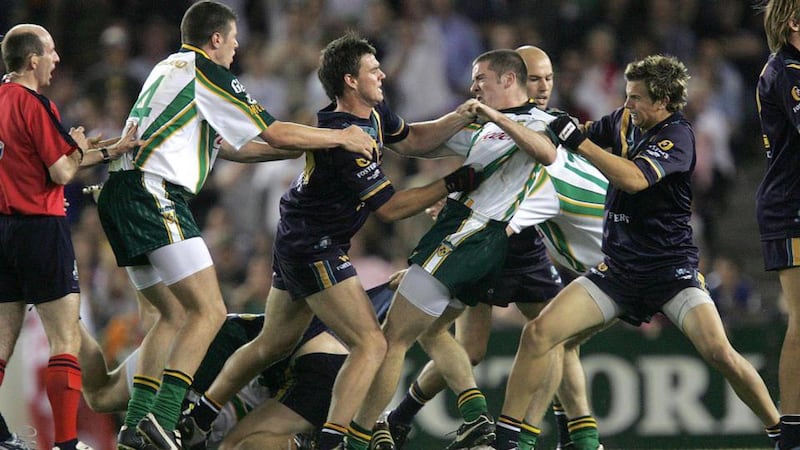On Saturday evening in Perth, 30 years after it officially started, the International Rules series between Ireland and Australia could be on it last lap.
Given a profile that in the relatively recent past attracted crowds of 70,000 and 80,000 to Croke Park and over 60,000 to the Melbourne Cricket Ground, how did the series get to this impasse? The current situation has to acknowledge for the past 10 years the international project has been in decline. Many of the setbacks have been self-inflicted.
– The GAA should have pursued the bad behaviour of the Australians in 2004 instead of drawing a veil over it because Ireland had won easily.

– Under Kevin Sheedy in 2005 and '06 the AFL sides produced the best football played by any team in the history of the series but also chose recklessly to disregard any sort of disciplined restraint and the ensuing violence hugely undermined the series.
– By opting not to play in 2007 and then pushing a twice-in-three-years cycle, the GAA further undermined the internationals by making them movable feasts and removing their slot in the games calendars of both countries.
– The indifference of the AFL in fielding poor-quality sides in a number of series was the biggest factor in making the Tests frequently one-sided and of rapidly declining interest to followers in either hemisphere.
The indiscipline issue was probably the most costly, simply because so many of the other problems flowed from it.
Inhibited play
The gap years and lecturing of the AFL, which led to inhibited play as Australia teams did their utmost to be on their best behaviour and at the same time cope with rule changes to soften the impact of their growing superiority, helped dilute public interest in the series and by extension player interest. This year the AFL set out to give the series full backing and were successful in attracting a very strong panel. The momentum for this came from last year’s dismally one-sided Test series in Ireland when a team restricted to indigenous players received a record beating. AFL sources privately maintain they couldn’t interest top players in the trip to Ireland.
The embarrassment prompted administrators and elite players to try to address the issue with the most frequently quoted statistics being that there are seven club captains in the Australia squad and eight current All-Australians (compared with five of this year’s All Stars on the Ireland team). The problem remains though this belated attention paid to the series may have come too late. It is also hard to work out what precisely the Australian intentions are in the long term.
Shamed into fielding a decent team this year, the AFL aren’t guaranteed to be able to do the same thing in future years. Are they primarily interested in setting the record straight after last year and letting the game fall into abeyance or trying to get it back on to a secure basis?
Two factors affect this: the reduced close season makes the old October dates impractical whereas this year’s idea of playing the series as a one-match Test in November, when the pre-season has started, may have worked this time but the scheduling gives increased power to the clubs, not all of which are supporters of the internationals.
This ironically has been most visible in Carlton’s advising the three Irish players on the club’s books not to get involved in the series.
Publicity – allowing some of it has come from the presence of two Essendon players facing investigation for doping offences in the home squad – has been better for the match than in the past two series in Australia and with only one match to promote the prospect of a reasonable crowd is high with Patersons Stadium set to sell out its 40,000 capacity.
Since the departure of Andrew Demetriou as AFL chief executive, GAA officials feel the internationals occupy a higher priority on the AFL's agenda, as his successor Gillon McLachlan is said to be more engaged.
New York
In the past couple of days Mark Evans, the AFL operations manager has been talking about playing a Test in New York in the future – a flier, which prompted Ireland manager
Paul Earley
to suggest diplomatically that maybe the internationals should be got onto firmer footing in the two competing countries before making plans for world domination.
Yet the fact is with the Australians more focused the internationals are at least in improved circumstances compared to recent years.
The problem is Saturday’s match has to tick just about every box on the page: competitive and aggressive but also disciplined, well attended and featuring a decent standard of play. In the past 10 years few enough of the internationals have satisfied those criteria.
Concentrating on the practical difficulties also overlooks a fundamental failure of vision on both sides. That is an inability to create a convincing narrative bringing together two great indigenous sports with enough in common to synthesise a game that at its best attracted huge crowds to watch it being contested.
Maybe it was just novelty that has now worn off but 12 years ago when before the second Test at Croke Park Australia captain Shane Crawford spoke to more than 70,000 people – on the anniversary of the Bali bombings, which had killed a number of AFL players – his themes of the universality of sport and human solidarity appeared more enduring than that. smoran@irishtimes.com









